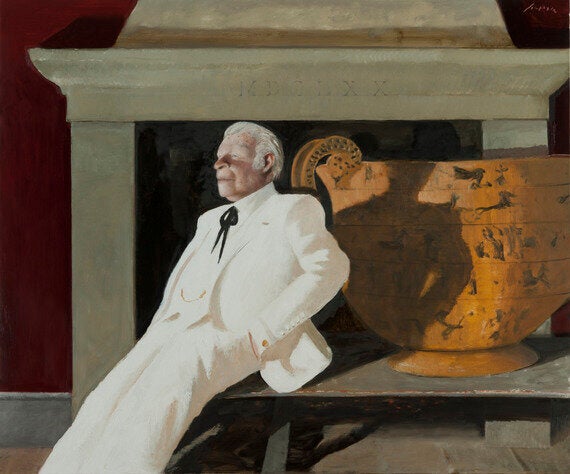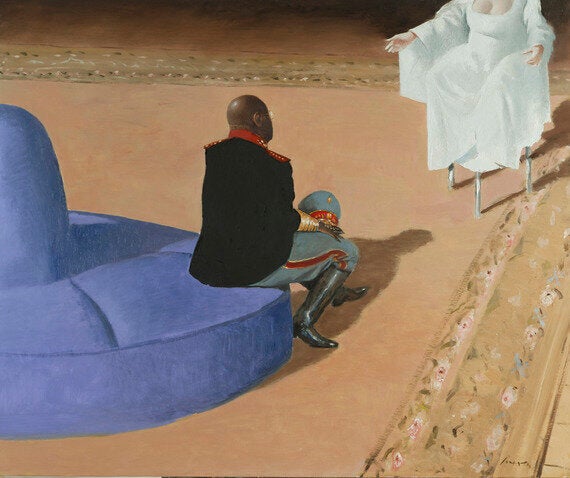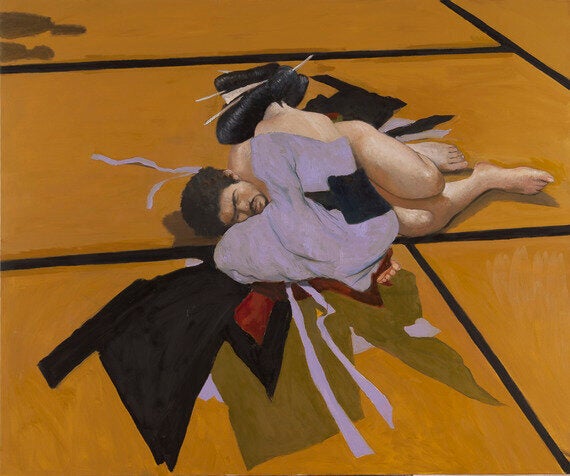Possessing a fascinating oeuvre that includes paintings, sculptors and caricatures, Julio Larraz is now recognised as one of the most important contemporary Latin American artists of our time. Born in Havana, Cuba in 1941, Larraz and his family found themselves politically exiled, and so fled to America. Here Larraz began his artistic career, drawing political caricatures that were featured in The New York Times, The Chicago Tribune and Vogue, amongst other prominent American publications. Only some years later did Larraz assume his place as a full-time painter, and held a number of solo exhibitions across North America. Larraz was warmly received by the American art scene, and he too embraced American art; citing a number of New York artists as influences, particularly that of Burt Silverman.

Larraz utilises an inexhaustible colour palette, for each of his paintings feature a bold and vibrant use of colour, that we now consider the artist's signature style. This has often been viewed as reflective of Larraz's Caribbean heritage, as has his use of maritime landscapes. Whilst such a conclusion is justifiable, Larraz is sure to remind us that his paintings are simply suggestive of place, as opposed to depicting an exact location. Rather his artistry is more concerned with the construction of meaning through metaphor and symbolism. This in turn creates paintings that are poem-like, due to the layered meaning and openness to numerous interpretations.
Larraz encourages his observers to decode the art that stands before their eyes, believing it is the artist whom should be "revealing that which reality conceals". In fulfilling this responsibility, Larraz experiments with styles to create works that are incredibly postmodern. Deconstructed bodies and objects feature heavily throughout his body of work, and these fragmented pieces are further distorted by an exaggerated use of scale. Larraz also borrows references from classical mythology, although this is by no means an attempt to imitate such models. Rather Larraz situates such references away from their usual context, focusing on their form or colour instead, in order to demonstrate the fragility of the power and importance we assign to aspects of the world.

One only has to take a look at the human figures that Larraz depicts to realise he poses more questions than he provides answers. Similar to American realist painter Edward Hopper, faces in Larraz's paintings are often only revealed partially, and facial characteristics are secondary to the figure's clothing, or lack thereof. This again contributes to Larraz's emphasis on the metaphorical as well as the figurative, for his attention to detail concerning what the figures wear capitalises on clothing's ability to act as a signifier for class, sexuality, or even religion.
The protagonists are also captured mid-conversation, and the angle of the perspective creates an almost peering-in effect, as if we are gaining insight into a private moment. This may resonate with some spectators as reminiscent of a candid photograph, and it also gives the artworks an element of movement. Yet we do not know who these figures are, or even what these conversations consist of. Rather we must fill in the blanks ourselves, and in doing so the painting transcends the canvas, establishing an interaction between artist and spectator.
Larraz's artistic methods are equally as fascinating as the work he produces. His brushstrokes are confident and effortless, demonstrating true masterful artistic talent. Speaking on his work, Larraz explains his paintings appear in his mind as images, that he must capture before they dissolve just as dreams do.
"I attempt to create a different reality where dreams serve as the foundations for a parallel universe"
In such context, we must view Larraz's art as suspended between reality and dream, and thus entering the subconscious. Using art to express his subconscious understanding of his own reality, Larraz's body of work is philosophical and therefore surrealistic. Dipping into the world of dreams, Larraz invokes feelings of mystery and intrigue, as well as unsettledness, melancholy and nostalgia. Whilst regular motifs do appear throughout the exhibited works, the meaning they represent does not always remain the same. Rather Larraz changes them, just as our responses to life alter with the passing of time and gained knowledge.
An artistic connoisseur, Larraz has developed a style that is unique and instantly identifiable. Much loved and celebrated in America, his works have been featured in a number of public collections, including the Herbert F. John Museum of Art in New York and has been included in a corporate collection at World Bank, Washington D.C. Exhibitions of his works have also taken place in Venice, Spain and France.

Julio Larraz: Rules of Engagements
Exhibition runs from the 3rd October - 24th November
ContiniArtUK Gallery
105 New Bond St
W1S 1DN London